新课改单元整体教学设计人教版七年级上册Unit 4 Where's my schoolbag?(表格式 4课时)
文档属性
| 名称 | 新课改单元整体教学设计人教版七年级上册Unit 4 Where's my schoolbag?(表格式 4课时) | 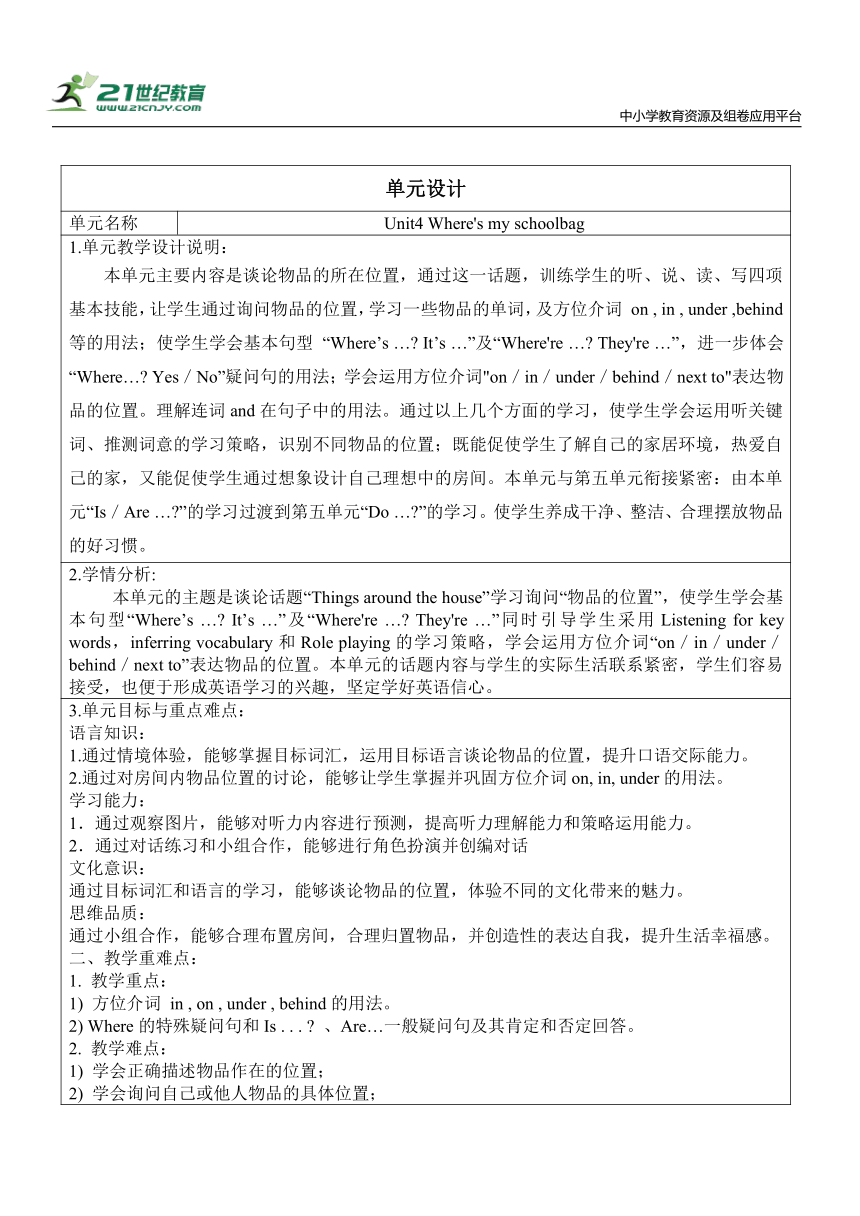 | |
| 格式 | docx | ||
| 文件大小 | 59.7KB | ||
| 资源类型 | 试卷 | ||
| 版本资源 | 人教新目标(Go for it)版 | ||
| 科目 | 英语 | ||
| 更新时间 | 2023-12-22 09:08:11 | ||
图片预览

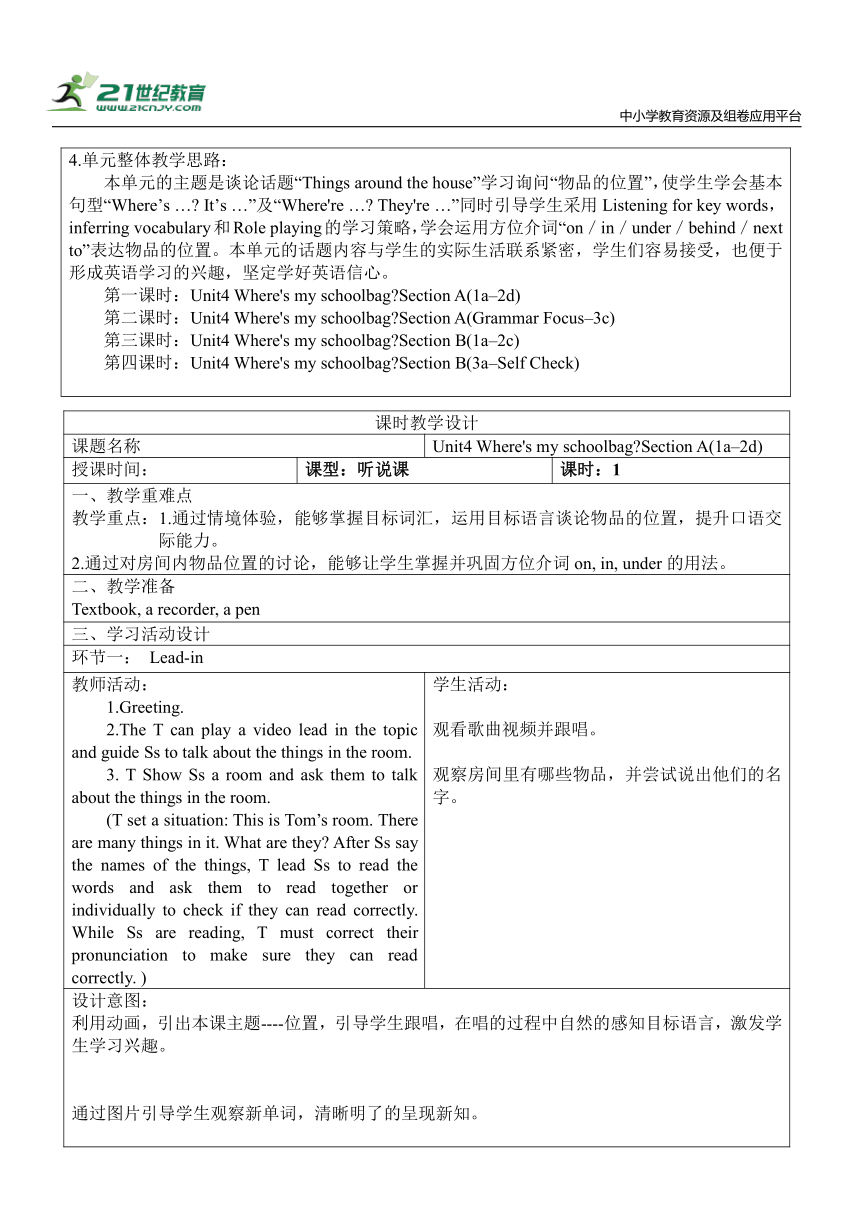
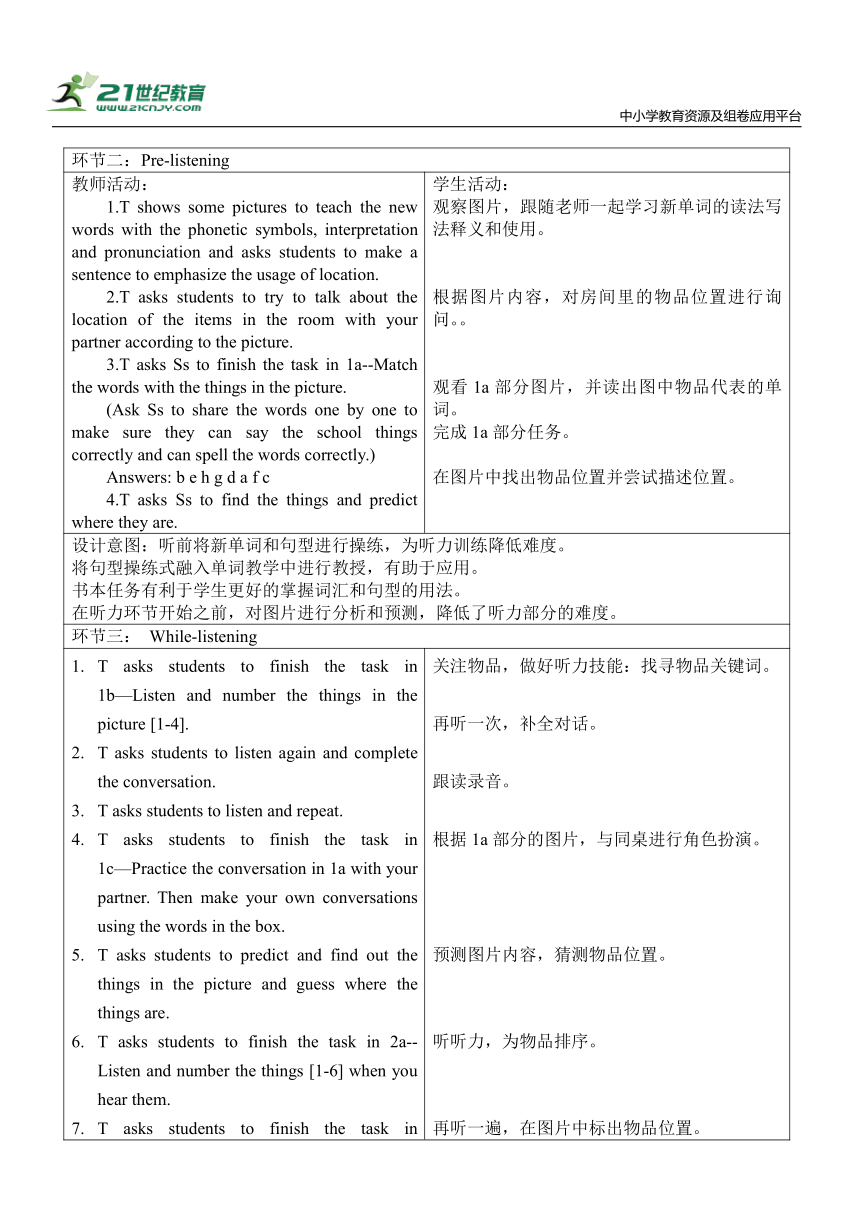
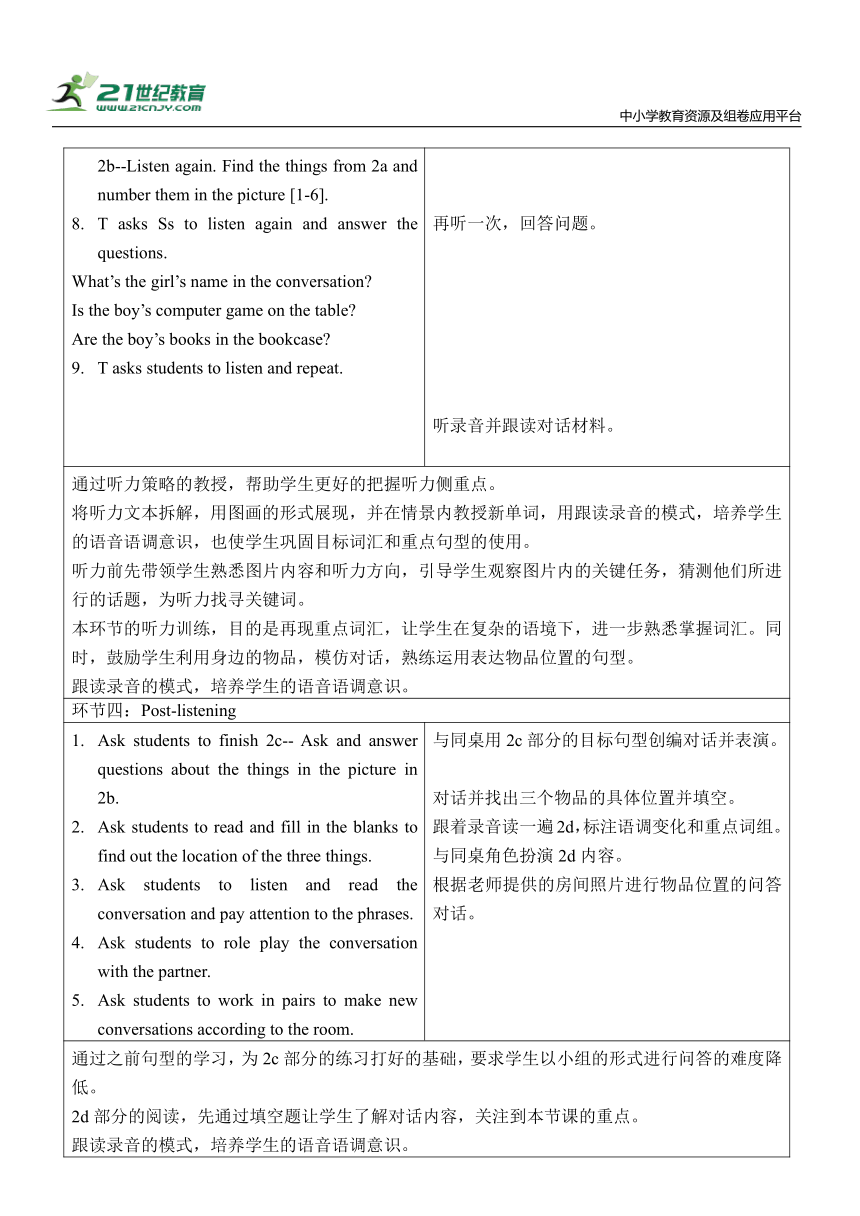
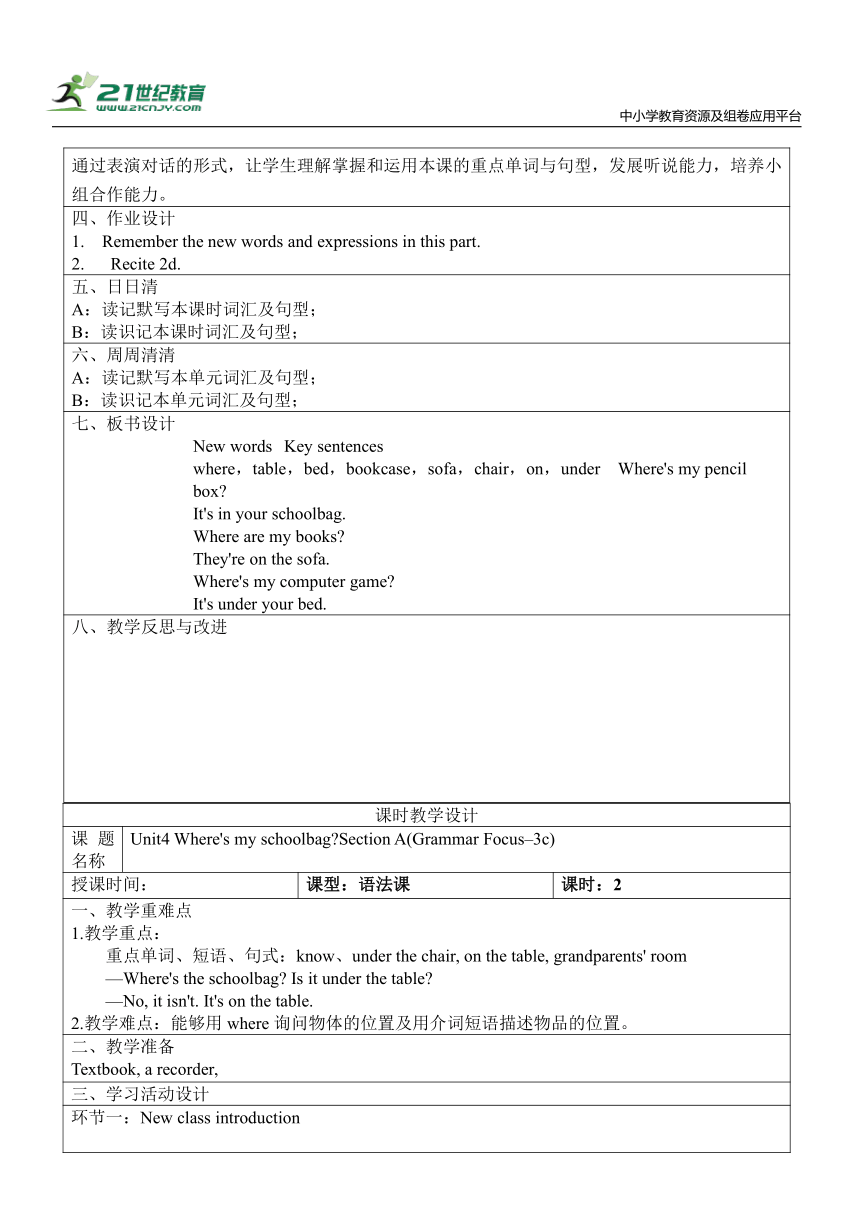
文档简介
中小学教育资源及组卷应用平台
单元设计
单元名称 Unit4 Where's my schoolbag
1.单元教学设计说明: 本单元主要内容是谈论物品的所在位置,通过这一话题,训练学生的听、说、读、写四项基本技能,让学生通过询问物品的位置,学习一些物品的单词,及方位介词 on , in , under ,behind 等的用法;使学生学会基本句型 “Where’s … It’s …”及“Where're … They're …”,进一步体会“Where… Yes/No”疑问句的用法;学会运用方位介词"on/in/under/behind/next to"表达物品的位置。理解连词and在句子中的用法。通过以上几个方面的学习,使学生学会运用听关键词、推测词意的学习策略,识别不同物品的位置;既能促使学生了解自己的家居环境,热爱自己的家,又能促使学生通过想象设计自己理想中的房间。本单元与第五单元衔接紧密:由本单元“Is/Are … ”的学习过渡到第五单元“Do … ”的学习。使学生养成干净、整洁、合理摆放物品的好习惯。
2.学情分析: 本单元的主题是谈论话题“Things around the house”学习询问“物品的位置”,使学生学会基本句型“Where’s … It’s …”及“Where're … They're …”同时引导学生采用Listening for key words,inferring vocabulary和Role playing的学习策略,学会运用方位介词“on/in/under/behind/next to”表达物品的位置。本单元的话题内容与学生的实际生活联系紧密,学生们容易接受,也便于形成英语学习的兴趣,坚定学好英语信心。
3.单元目标与重点难点: 语言知识: 1.通过情境体验,能够掌握目标词汇,运用目标语言谈论物品的位置,提升口语交际能力。 2.通过对房间内物品位置的讨论,能够让学生掌握并巩固方位介词on, in, under的用法。 学习能力: 1.通过观察图片,能够对听力内容进行预测,提高听力理解能力和策略运用能力。 2.通过对话练习和小组合作,能够进行角色扮演并创编对话 文化意识: 通过目标词汇和语言的学习,能够谈论物品的位置,体验不同的文化带来的魅力。 思维品质: 通过小组合作,能够合理布置房间,合理归置物品,并创造性的表达自我,提升生活幸福感。 二、教学重难点: 1. 教学重点: 1) 方位介词 in , on , under , behind的用法。 2) Where的特殊疑问句和Is . . . 、Are…一般疑问句及其肯定和否定回答。 2. 教学难点: 1) 学会正确描述物品作在的位置; 2) 学会询问自己或他人物品的具体位置;
4.单元整体教学思路: 本单元的主题是谈论话题“Things around the house”学习询问“物品的位置”,使学生学会基本句型“Where’s … It’s …”及“Where're … They're …”同时引导学生采用Listening for key words,inferring vocabulary和Role playing的学习策略,学会运用方位介词“on/in/under/behind/next to”表达物品的位置。本单元的话题内容与学生的实际生活联系紧密,学生们容易接受,也便于形成英语学习的兴趣,坚定学好英语信心。 第一课时:Unit4 Where's my schoolbag Section A(1a–2d) 第二课时:Unit4 Where's my schoolbag Section A(Grammar Focus–3c) 第三课时:Unit4 Where's my schoolbag Section B(1a–2c) 第四课时:Unit4 Where's my schoolbag Section B(3a–Self Check)
课时教学设计
课题名称 Unit4 Where's my schoolbag Section A(1a–2d)
授课时间: 课型:听说课 课时:1
一、教学重难点 教学重点:1.通过情境体验,能够掌握目标词汇,运用目标语言谈论物品的位置,提升口语交际能力。 2.通过对房间内物品位置的讨论,能够让学生掌握并巩固方位介词on, in, under的用法。
二、教学准备 Textbook, a recorder, a pen
三、学习活动设计
环节一: Lead-in
教师活动: 1.Greeting. 2.The T can play a video lead in the topic and guide Ss to talk about the things in the room. 3. T Show Ss a room and ask them to talk about the things in the room. (T set a situation: This is Tom’s room. There are many things in it. What are they After Ss say the names of the things, T lead Ss to read the words and ask them to read together or individually to check if they can read correctly. While Ss are reading, T must correct their pronunciation to make sure they can read correctly. ) 学生活动: 观看歌曲视频并跟唱。 观察房间里有哪些物品,并尝试说出他们的名字。
设计意图: 利用动画,引出本课主题----位置,引导学生跟唱,在唱的过程中自然的感知目标语言,激发学生学习兴趣。 通过图片引导学生观察新单词,清晰明了的呈现新知。
环节二:Pre-listening
教师活动: 1.T shows some pictures to teach the new words with the phonetic symbols, interpretation and pronunciation and asks students to make a sentence to emphasize the usage of location. 2.T asks students to try to talk about the location of the items in the room with your partner according to the picture. 3.T asks Ss to finish the task in 1a--Match the words with the things in the picture. (Ask Ss to share the words one by one to make sure they can say the school things correctly and can spell the words correctly.) Answers: b e h g d a f c 4.T asks Ss to find the things and predict where they are. 学生活动: 观察图片,跟随老师一起学习新单词的读法写法释义和使用。 根据图片内容,对房间里的物品位置进行询问。。 观看1a部分图片,并读出图中物品代表的单词。 完成1a部分任务。 在图片中找出物品位置并尝试描述位置。
设计意图:听前将新单词和句型进行操练,为听力训练降低难度。 将句型操练式融入单词教学中进行教授,有助于应用。 书本任务有利于学生更好的掌握词汇和句型的用法。 在听力环节开始之前,对图片进行分析和预测,降低了听力部分的难度。
环节三: While-listening
T asks students to finish the task in 1b—Listen and number the things in the picture [1-4]. T asks students to listen again and complete the conversation. T asks students to listen and repeat. T asks students to finish the task in 1c—Practice the conversation in 1a with your partner. Then make your own conversations using the words in the box. T asks students to predict and find out the things in the picture and guess where the things are. T asks students to finish the task in 2a-- Listen and number the things [1-6] when you hear them. T asks students to finish the task in 2b--Listen again. Find the things from 2a and number them in the picture [1-6]. T asks Ss to listen again and answer the questions. What’s the girl’s name in the conversation Is the boy’s computer game on the table Are the boy’s books in the bookcase T asks students to listen and repeat. 关注物品,做好听力技能:找寻物品关键词。 再听一次,补全对话。 跟读录音。 根据1a部分的图片,与同桌进行角色扮演。 预测图片内容,猜测物品位置。 听听力,为物品排序。 再听一遍,在图片中标出物品位置。 再听一次,回答问题。 听录音并跟读对话材料。
通过听力策略的教授,帮助学生更好的把握听力侧重点。 将听力文本拆解,用图画的形式展现,并在情景内教授新单词,用跟读录音的模式,培养学生的语音语调意识,也使学生巩固目标词汇和重点句型的使用。 听力前先带领学生熟悉图片内容和听力方向,引导学生观察图片内的关键任务,猜测他们所进行的话题,为听力找寻关键词。 本环节的听力训练,目的是再现重点词汇,让学生在复杂的语境下,进一步熟悉掌握词汇。同时,鼓励学生利用身边的物品,模仿对话,熟练运用表达物品位置的句型。 跟读录音的模式,培养学生的语音语调意识。
环节四:Post-listening
Ask students to finish 2c-- Ask and answer questions about the things in the picture in 2b. Ask students to read and fill in the blanks to find out the location of the three things. Ask students to listen and read the conversation and pay attention to the phrases. Ask students to role play the conversation with the partner. Ask students to work in pairs to make new conversations according to the room. 与同桌用2c部分的目标句型创编对话并表演。 对话并找出三个物品的具体位置并填空。 跟着录音读一遍2d,标注语调变化和重点词组。 与同桌角色扮演2d内容。 根据老师提供的房间照片进行物品位置的问答对话。
通过之前句型的学习,为2c部分的练习打好的基础,要求学生以小组的形式进行问答的难度降低。 2d部分的阅读,先通过填空题让学生了解对话内容,关注到本节课的重点。 跟读录音的模式,培养学生的语音语调意识。 通过表演对话的形式,让学生理解掌握和运用本课的重点单词与句型,发展听说能力,培养小组合作能力。
四、作业设计 1. Remember the new words and expressions in this part. 2. Recite 2d.
五、日日清 A:读记默写本课时词汇及句型; B:读识记本课时词汇及句型;
六、周周清清 A:读记默写本单元词汇及句型; B:读识记本单元词汇及句型;
七、板书设计 New words Key sentences where,table,bed,bookcase,sofa,chair,on,under Where's my pencil box It's in your schoolbag. Where are my books They're on the sofa. Where's my computer game It's under your bed.
八、教学反思与改进
课时教学设计
课题名称 Unit4 Where's my schoolbag Section A(Grammar Focus–3c)
授课时间: 课型:语法课 课时:2
一、教学重难点 1.教学重点: 重点单词、短语、句式:know、under the chair, on the table, grandparents' room —Where's the schoolbag Is it under the table —No, it isn't. It's on the table. 2.教学难点:能够用where询问物体的位置及用介词短语描述物品的位置。
二、教学准备 Textbook, a recorder,
三、学习活动设计
环节一:New class introduction
教师活动: T:Where’s your pen T: Is your pen on the desk 学生活动: S: My pen is on my pencil box. S: No, it isn’t.
设计意图:1.这个问题是为了操练日常用语及对姓名的提问法;同时为这堂新课的学习做好铺垫。建议让多个Ss作答。鼓励他们大胆开口。然后再由同学间交流,并请同学表演。可以采用“连珠炮似的提问”(老师提问,学生迅速反应)和“连锁操练”(学生任意提问或排头开始一一提问至排尾)方法。T在操练期间板书这些词。 2.此问重点操练his, her my your这几个物主代词的用法及英文名字的使用。建议T用夸张语调重读这些词并用彩色粉笔板书。
环节二: The new class open up before one's eyes
教师活动: [Complete the teaching task of textbook Grammar Focus~3c] 1. Students should read the sentences in the Grammar Focus aloud. 2. Summary of the training. 3. Teaching3a. See the picture to complete the conversation. 4. Teaching 3b. Answer with peers according to the items on the right.Code reference A: Where's… Is it on… B: No, it isn't. It's under… 5. Teaching 3c. Student A looks at the picture on page 19, student B looks at the picture on the right of 3c, and finds out the differences through questions and answers. [Syntax Summary] 1. Ansto where-led questions come in the following three forms: (1) Use the It's + prepositional phrase (corresponding to Where is... ) Or They're + prepositional phrase (corresponding to Where are... )。 Example: - -Where's my hat Where is my hat - -It's on your head. It's on your head. (2) You can directly answer the location of the item, omit it's or they're. Ex. sentence: - -Where are your parents Where are your parents — — In the room. In the room. (3) When you don't know where, "Idon' t know.", " I don't know.” Example: - -Where's my bag Where is my schoolbag - -ITO 't know. I don't know. Note: don't=do not, where do is the auxiliary verb, when the subject is the third person singular, the auxiliary verb applies does, abbreviated as doesn't. She doesn't know. She doesn't know. 2. Usage of the preposition in, on and under Both in, on, under are prepositions for orientation. (1) In means "in..., in...", usually in a certain space. The ring is in the bag. The ring is in the bag. Expansion: in can also indicate the location, in a certain year, month, century, morning, evening, and what language to use. For example: in Wuhan in Wuhan in the morning in the morning of in 2014 in 2014 in English In the English language (2) On means "above...", indicating the phase contact between objects. A cup is on the desk. There is a cup on the desk. Expansion: on can also represent the time (after a specific day). For example: on Monday is on Monday (3) under means "below...". For example: under the desk Under the desk 学生活动: Ss :read and practice and take notes. Ss :My name is.../I’m..
设计意图:通过练习提高学生的感知能力以及逻辑思维能力。
环节三: Learn to practice
( B )1.—Where are your books —_______ on the desk. A. It's B. They're C. They ( B )2.The students are _______ the classroom. on B. in C. unde
设计意图:练习巩固知识。
四、作业设计 1. Remember the new words and expressions in this part. 2. Recite sentences.
五、日日清 A:读记默写本课时词汇及句型; B:读识记本课时词汇及句型;
六、周周清清 A:读记默写本单元词汇及句型; B:读识记本单元词汇及句型;
七、板书设计 Unit4 Where's my schoolbag Section A(Grammar Focus–3c) 形容词性物主代词 Where is/are....... 我的 my 你的 your,我们的是 our。 男他的是 his,女她的是 her。 Its 它的牢记着,他们的 their 指复数。
八、教学反思与改进
课时教学设计
课题名称 Unit4 Where's my schoolbag Section B(1a–2c)
授课时间: 课型:阅读课 课时:3
教学重难点 1.方位介词的使用物品的名称。 2.阅读技巧。
二、教学准备 Textbook, 多媒体
三、学习活动设计
环节一:Warming-up
教师活动: 1. 教师把一些已学过的物品放在某些位置,然后和学生对话。 T: Where’s the schoolbag T: Where are the books 2. 做一个游戏。教师把pen, ruler, eraser等小物件放在某些位置(不让学生看),让学生猜他们在什么位置,奖励优胜者。 学生活动: S: It’s on the desk. S: They’re in the schoolbag.
设计意图:调动学生的积极性高,既从学生的兴趣出发,又具备易操作的特点 。
环节二: The new class open up before one's eyes
教师活动: 【完成教材1a~1e的教学任务】 1. 教学1a。将1a图片中的物品与方框中的单词配对。 2. 让学生读单词,教师纠正发音。 3. 看1a中的图片3分钟,然后合上课本,写出你所记住的物品单词,完成1b。 4. 教学1c。听录音,圈出房间里汤姆想要的物品。 5. 教学1d。再听录音,记下汤姆想要的物品的位置。 6. 听录音,学生跟读。教师注意纠音。 7. 教学1e。根据汤姆房间里物品的位置进行问答。 8. 学生根据自己所用的学习用具进行问答。 【语法提要】 1. clock 例句:I get up at six o’clock. 我6点钟起床。 —What time is it 几点了? —It’s ten (o’clock). 10 点了。 ( o’clock可以省略) 2. 名词短语 tape player与model plane都是由两个名词构成的短语。其中,前一个名词已形容词化,用作定语,说明后一个名词的功能、特性。在变复数名词短语时,只需把后一个名词变复数。 例如: English book—English books tree leaf—tree leaves tape player—tape players computer game—computer games model plane—model planes an apple tree—two apple trees (2)第一个名词是复数形式时,将第二个名词变为复数。 例如: a sports meeting—two sports meetings (两场运动会)a clothes store—some clothes stores(一些服装) 【完成教材2a~2c的教学任务】 1. 教学2a。让学生看2a的图,写出图中他们知道的物品名称。 2. 教学2b。阅读2b短文, 回答问题: (1)Is Kate tidy (2)Is Gina tidy (3)Where are Gina’s books 3. 放课文2b录音,让学生跟读。 4. 教师根据学生掌握情况对重难点进行讲解。 5. 让个别学生朗读课文。 6. 教学2c。教学生根据2b中凯特和吉娜拥有的物品及其位置完成表格2c。 7. 让学生根据2c表格中的信息进行问答。 典例参考 A: Where are Kate’s books and tapes B: They are in the bookcase. 【语法提要】 1. but but是连词,可以连接两个并列成分(单词、短语或并列分句),表示前后意义上的转折或两种情况的对比,意为“但是,然而,可是”。 例句: My books are on the desk, but hers aren’t. 我的书在书桌上,但是她的(书)不在。 拓展: but的用法: (1)连接两个并列成分或两个并列分句,意为“但是, 然而”。 例句: I am tired but happy. 我很累却很开心。 (2)用于道歉的表达之后,引起一个分句,此时but本身无意义。 例句: Sorry, but I have to go. 对不起,我必须走了。 (3)用在某些否定语后,表示“只……”。 例句: She knows no languages but Chinese. 她只懂汉语。 2. everywhere everywhere为副词,意为“处处; 到处; 各个地方”,相当于“here and there ”。 例句:In spring, we can see flowers everywhere. 在春天,我们到处都能看到花。 The balls are everywhere. 球到处都是。 拓展:当everywhere用于否定句中时,是不完全否定,表示“并非处处都”。 例句:You can’t be pleased everywhere. 你不可能在任何地方都心情舒畅。 3. always always作副词,意为“总是, 始终,永远”,常用在一般现在时中,表示动作发生的频率。 例句:The girl is always late for school. 那女孩总是上学迟到。 She always likes to ask why. 她总是喜欢问为什么。 拓展: always 与 be 动词连用时,放在be动词之后;与实义动词连用时,则放在实义动词之前。 例句: He always gets up late. 他总是起床晚。 学生活动: Ss: Complete 1a~1e
设计意图: 练习句型,锻炼交际能力并描述物品位置关系。
环节三: Learn to practice
1. 钟在桌子上。(汉译英) The clock is on the table. ( D )2. There are fifty _______ in our school. They are all friendly to us. A. woman teachers B. women teacher C. woman teacher D. women teachers ( D )3. I’d like to go with you, ________I’m too busy. A. or B. and C. so D. but ( A )4. My sister ________ goes to bed early(早) because she needs a lot of sleep(因为她需要很多的睡眠) every day. A. always B. sometimes C. hardly D. never 5. 根据汉语提示,完成句子。 We can see litter(垃圾) everywhere (到处).
设计意图:通过练习题对本课时进行一个练习
四、作业设计 总结本单元知识,并完成习题册。
五、日日清 A:读记默写本课时词汇及句型; B:读记识本课时词汇及句型;
六、周周清清 A:读记默写本单元词汇及句型; B:读记识本单元词汇及句型;
七、板书设计 Unit4 Where's my schoolbag Section B(1a–2c) Where is/are............. It is...... They are......
八、教学反思与改进
课时教学设计
课题名称 Unit4 Where's my schoolbag Section B(3a–Self Check)
授课时间: 课型:综合课 课时:4
教学重难点 教学重点:重点短语 on the teacher’s desk, a pencil box 重点句式 My dictionary and my radio are on the desk. 教学难点:目标语言句子写作技巧。
二、教学准备 Textbook, 多媒体
三、学习活动设计
环节一:Warming-up and revision.
教师活动: T: Hello, everyone! What do you have in your room Where are they 典例参考: Here is my room. My TV is on the desk. My watch is on the bed. My ball is under the chair… 学生活动: S: (Say something about their bedrooms)…
设计意图:在这个活动中,学生的积极性很高,既从学生的兴趣出发,又具备易操作的特点 。
环节二: Presentation
教师活动: 【完成教材3a~3b的教学任务】 1. 填写3a中的表格,并在小组内互相交流。 2. 教学3b。学生写出自己房间里的物品,尝试在句中使用and, 并大声读出自己的句子。 典例参考 1. My dictionary and my radio are on the desk. 2. My pencil box is in my schoolbag and my schoolbag is under the desk. 【完成教材Self Check的教学任务】 1. 学生按类别写出自己房间里的物品。 2. 学生用in, on和under写出教室里物品的位置,并读出自己的句子。 典例参考 The tape player is on the teacher’s desk. … 学生活动: Communicate within the group Students write items in their room, try to use and in sentences and read their own sentences aloud.
设计意图: 练习句型,锻炼交际能力并学会写。
环节三: Learn to practice
选择方框中的单词补全对话。 yes, on, your , where, not, know, here, they, are A: Mum, where is my schoolbag? B: I don’t know . Is it under the chair A: No, it isn’t. B: Is it on the sofa A: Oh, yes. Here it is. But(但是)where are my books They are not in the schoolbag. B: Are they in the bookcase A: No, they’re not. They are on the dresser. B: Are your keys on the dresser, too A: Yes , they are.
设计意图:进行一个综合的练习
四、作业设计 写一个“自我房间介绍 ”将本节课所学的知识得以提升,字数不限。
五、日日清 A:读记默写本课时词汇及句型; B:读记识本课时词汇及句型;
六、周周清清 A:读记默写本单元词汇及句型; B:读记识本单元词汇及句型;
七、板书设计 Unit4 Where's my schoolbag Section B(3a–Self Check) Hello!I’m Gina,This is my room,Let me tell you about my room .....
八、教学反思与改进
单元设计
单元名称 Unit4 Where's my schoolbag
1.单元教学设计说明: 本单元主要内容是谈论物品的所在位置,通过这一话题,训练学生的听、说、读、写四项基本技能,让学生通过询问物品的位置,学习一些物品的单词,及方位介词 on , in , under ,behind 等的用法;使学生学会基本句型 “Where’s … It’s …”及“Where're … They're …”,进一步体会“Where… Yes/No”疑问句的用法;学会运用方位介词"on/in/under/behind/next to"表达物品的位置。理解连词and在句子中的用法。通过以上几个方面的学习,使学生学会运用听关键词、推测词意的学习策略,识别不同物品的位置;既能促使学生了解自己的家居环境,热爱自己的家,又能促使学生通过想象设计自己理想中的房间。本单元与第五单元衔接紧密:由本单元“Is/Are … ”的学习过渡到第五单元“Do … ”的学习。使学生养成干净、整洁、合理摆放物品的好习惯。
2.学情分析: 本单元的主题是谈论话题“Things around the house”学习询问“物品的位置”,使学生学会基本句型“Where’s … It’s …”及“Where're … They're …”同时引导学生采用Listening for key words,inferring vocabulary和Role playing的学习策略,学会运用方位介词“on/in/under/behind/next to”表达物品的位置。本单元的话题内容与学生的实际生活联系紧密,学生们容易接受,也便于形成英语学习的兴趣,坚定学好英语信心。
3.单元目标与重点难点: 语言知识: 1.通过情境体验,能够掌握目标词汇,运用目标语言谈论物品的位置,提升口语交际能力。 2.通过对房间内物品位置的讨论,能够让学生掌握并巩固方位介词on, in, under的用法。 学习能力: 1.通过观察图片,能够对听力内容进行预测,提高听力理解能力和策略运用能力。 2.通过对话练习和小组合作,能够进行角色扮演并创编对话 文化意识: 通过目标词汇和语言的学习,能够谈论物品的位置,体验不同的文化带来的魅力。 思维品质: 通过小组合作,能够合理布置房间,合理归置物品,并创造性的表达自我,提升生活幸福感。 二、教学重难点: 1. 教学重点: 1) 方位介词 in , on , under , behind的用法。 2) Where的特殊疑问句和Is . . . 、Are…一般疑问句及其肯定和否定回答。 2. 教学难点: 1) 学会正确描述物品作在的位置; 2) 学会询问自己或他人物品的具体位置;
4.单元整体教学思路: 本单元的主题是谈论话题“Things around the house”学习询问“物品的位置”,使学生学会基本句型“Where’s … It’s …”及“Where're … They're …”同时引导学生采用Listening for key words,inferring vocabulary和Role playing的学习策略,学会运用方位介词“on/in/under/behind/next to”表达物品的位置。本单元的话题内容与学生的实际生活联系紧密,学生们容易接受,也便于形成英语学习的兴趣,坚定学好英语信心。 第一课时:Unit4 Where's my schoolbag Section A(1a–2d) 第二课时:Unit4 Where's my schoolbag Section A(Grammar Focus–3c) 第三课时:Unit4 Where's my schoolbag Section B(1a–2c) 第四课时:Unit4 Where's my schoolbag Section B(3a–Self Check)
课时教学设计
课题名称 Unit4 Where's my schoolbag Section A(1a–2d)
授课时间: 课型:听说课 课时:1
一、教学重难点 教学重点:1.通过情境体验,能够掌握目标词汇,运用目标语言谈论物品的位置,提升口语交际能力。 2.通过对房间内物品位置的讨论,能够让学生掌握并巩固方位介词on, in, under的用法。
二、教学准备 Textbook, a recorder, a pen
三、学习活动设计
环节一: Lead-in
教师活动: 1.Greeting. 2.The T can play a video lead in the topic and guide Ss to talk about the things in the room. 3. T Show Ss a room and ask them to talk about the things in the room. (T set a situation: This is Tom’s room. There are many things in it. What are they After Ss say the names of the things, T lead Ss to read the words and ask them to read together or individually to check if they can read correctly. While Ss are reading, T must correct their pronunciation to make sure they can read correctly. ) 学生活动: 观看歌曲视频并跟唱。 观察房间里有哪些物品,并尝试说出他们的名字。
设计意图: 利用动画,引出本课主题----位置,引导学生跟唱,在唱的过程中自然的感知目标语言,激发学生学习兴趣。 通过图片引导学生观察新单词,清晰明了的呈现新知。
环节二:Pre-listening
教师活动: 1.T shows some pictures to teach the new words with the phonetic symbols, interpretation and pronunciation and asks students to make a sentence to emphasize the usage of location. 2.T asks students to try to talk about the location of the items in the room with your partner according to the picture. 3.T asks Ss to finish the task in 1a--Match the words with the things in the picture. (Ask Ss to share the words one by one to make sure they can say the school things correctly and can spell the words correctly.) Answers: b e h g d a f c 4.T asks Ss to find the things and predict where they are. 学生活动: 观察图片,跟随老师一起学习新单词的读法写法释义和使用。 根据图片内容,对房间里的物品位置进行询问。。 观看1a部分图片,并读出图中物品代表的单词。 完成1a部分任务。 在图片中找出物品位置并尝试描述位置。
设计意图:听前将新单词和句型进行操练,为听力训练降低难度。 将句型操练式融入单词教学中进行教授,有助于应用。 书本任务有利于学生更好的掌握词汇和句型的用法。 在听力环节开始之前,对图片进行分析和预测,降低了听力部分的难度。
环节三: While-listening
T asks students to finish the task in 1b—Listen and number the things in the picture [1-4]. T asks students to listen again and complete the conversation. T asks students to listen and repeat. T asks students to finish the task in 1c—Practice the conversation in 1a with your partner. Then make your own conversations using the words in the box. T asks students to predict and find out the things in the picture and guess where the things are. T asks students to finish the task in 2a-- Listen and number the things [1-6] when you hear them. T asks students to finish the task in 2b--Listen again. Find the things from 2a and number them in the picture [1-6]. T asks Ss to listen again and answer the questions. What’s the girl’s name in the conversation Is the boy’s computer game on the table Are the boy’s books in the bookcase T asks students to listen and repeat. 关注物品,做好听力技能:找寻物品关键词。 再听一次,补全对话。 跟读录音。 根据1a部分的图片,与同桌进行角色扮演。 预测图片内容,猜测物品位置。 听听力,为物品排序。 再听一遍,在图片中标出物品位置。 再听一次,回答问题。 听录音并跟读对话材料。
通过听力策略的教授,帮助学生更好的把握听力侧重点。 将听力文本拆解,用图画的形式展现,并在情景内教授新单词,用跟读录音的模式,培养学生的语音语调意识,也使学生巩固目标词汇和重点句型的使用。 听力前先带领学生熟悉图片内容和听力方向,引导学生观察图片内的关键任务,猜测他们所进行的话题,为听力找寻关键词。 本环节的听力训练,目的是再现重点词汇,让学生在复杂的语境下,进一步熟悉掌握词汇。同时,鼓励学生利用身边的物品,模仿对话,熟练运用表达物品位置的句型。 跟读录音的模式,培养学生的语音语调意识。
环节四:Post-listening
Ask students to finish 2c-- Ask and answer questions about the things in the picture in 2b. Ask students to read and fill in the blanks to find out the location of the three things. Ask students to listen and read the conversation and pay attention to the phrases. Ask students to role play the conversation with the partner. Ask students to work in pairs to make new conversations according to the room. 与同桌用2c部分的目标句型创编对话并表演。 对话并找出三个物品的具体位置并填空。 跟着录音读一遍2d,标注语调变化和重点词组。 与同桌角色扮演2d内容。 根据老师提供的房间照片进行物品位置的问答对话。
通过之前句型的学习,为2c部分的练习打好的基础,要求学生以小组的形式进行问答的难度降低。 2d部分的阅读,先通过填空题让学生了解对话内容,关注到本节课的重点。 跟读录音的模式,培养学生的语音语调意识。 通过表演对话的形式,让学生理解掌握和运用本课的重点单词与句型,发展听说能力,培养小组合作能力。
四、作业设计 1. Remember the new words and expressions in this part. 2. Recite 2d.
五、日日清 A:读记默写本课时词汇及句型; B:读识记本课时词汇及句型;
六、周周清清 A:读记默写本单元词汇及句型; B:读识记本单元词汇及句型;
七、板书设计 New words Key sentences where,table,bed,bookcase,sofa,chair,on,under Where's my pencil box It's in your schoolbag. Where are my books They're on the sofa. Where's my computer game It's under your bed.
八、教学反思与改进
课时教学设计
课题名称 Unit4 Where's my schoolbag Section A(Grammar Focus–3c)
授课时间: 课型:语法课 课时:2
一、教学重难点 1.教学重点: 重点单词、短语、句式:know、under the chair, on the table, grandparents' room —Where's the schoolbag Is it under the table —No, it isn't. It's on the table. 2.教学难点:能够用where询问物体的位置及用介词短语描述物品的位置。
二、教学准备 Textbook, a recorder,
三、学习活动设计
环节一:New class introduction
教师活动: T:Where’s your pen T: Is your pen on the desk 学生活动: S: My pen is on my pencil box. S: No, it isn’t.
设计意图:1.这个问题是为了操练日常用语及对姓名的提问法;同时为这堂新课的学习做好铺垫。建议让多个Ss作答。鼓励他们大胆开口。然后再由同学间交流,并请同学表演。可以采用“连珠炮似的提问”(老师提问,学生迅速反应)和“连锁操练”(学生任意提问或排头开始一一提问至排尾)方法。T在操练期间板书这些词。 2.此问重点操练his, her my your这几个物主代词的用法及英文名字的使用。建议T用夸张语调重读这些词并用彩色粉笔板书。
环节二: The new class open up before one's eyes
教师活动: [Complete the teaching task of textbook Grammar Focus~3c] 1. Students should read the sentences in the Grammar Focus aloud. 2. Summary of the training. 3. Teaching3a. See the picture to complete the conversation. 4. Teaching 3b. Answer with peers according to the items on the right.Code reference A: Where's… Is it on… B: No, it isn't. It's under… 5. Teaching 3c. Student A looks at the picture on page 19, student B looks at the picture on the right of 3c, and finds out the differences through questions and answers. [Syntax Summary] 1. Ansto where-led questions come in the following three forms: (1) Use the It's + prepositional phrase (corresponding to Where is... ) Or They're + prepositional phrase (corresponding to Where are... )。 Example: - -Where's my hat Where is my hat - -It's on your head. It's on your head. (2) You can directly answer the location of the item, omit it's or they're. Ex. sentence: - -Where are your parents Where are your parents — — In the room. In the room. (3) When you don't know where, "Idon' t know.", " I don't know.” Example: - -Where's my bag Where is my schoolbag - -ITO 't know. I don't know. Note: don't=do not, where do is the auxiliary verb, when the subject is the third person singular, the auxiliary verb applies does, abbreviated as doesn't. She doesn't know. She doesn't know. 2. Usage of the preposition in, on and under Both in, on, under are prepositions for orientation. (1) In means "in..., in...", usually in a certain space. The ring is in the bag. The ring is in the bag. Expansion: in can also indicate the location, in a certain year, month, century, morning, evening, and what language to use. For example: in Wuhan in Wuhan in the morning in the morning of in 2014 in 2014 in English In the English language (2) On means "above...", indicating the phase contact between objects. A cup is on the desk. There is a cup on the desk. Expansion: on can also represent the time (after a specific day). For example: on Monday is on Monday (3) under means "below...". For example: under the desk Under the desk 学生活动: Ss :read and practice and take notes. Ss :My name is.../I’m..
设计意图:通过练习提高学生的感知能力以及逻辑思维能力。
环节三: Learn to practice
( B )1.—Where are your books —_______ on the desk. A. It's B. They're C. They ( B )2.The students are _______ the classroom. on B. in C. unde
设计意图:练习巩固知识。
四、作业设计 1. Remember the new words and expressions in this part. 2. Recite sentences.
五、日日清 A:读记默写本课时词汇及句型; B:读识记本课时词汇及句型;
六、周周清清 A:读记默写本单元词汇及句型; B:读识记本单元词汇及句型;
七、板书设计 Unit4 Where's my schoolbag Section A(Grammar Focus–3c) 形容词性物主代词 Where is/are....... 我的 my 你的 your,我们的是 our。 男他的是 his,女她的是 her。 Its 它的牢记着,他们的 their 指复数。
八、教学反思与改进
课时教学设计
课题名称 Unit4 Where's my schoolbag Section B(1a–2c)
授课时间: 课型:阅读课 课时:3
教学重难点 1.方位介词的使用物品的名称。 2.阅读技巧。
二、教学准备 Textbook, 多媒体
三、学习活动设计
环节一:Warming-up
教师活动: 1. 教师把一些已学过的物品放在某些位置,然后和学生对话。 T: Where’s the schoolbag T: Where are the books 2. 做一个游戏。教师把pen, ruler, eraser等小物件放在某些位置(不让学生看),让学生猜他们在什么位置,奖励优胜者。 学生活动: S: It’s on the desk. S: They’re in the schoolbag.
设计意图:调动学生的积极性高,既从学生的兴趣出发,又具备易操作的特点 。
环节二: The new class open up before one's eyes
教师活动: 【完成教材1a~1e的教学任务】 1. 教学1a。将1a图片中的物品与方框中的单词配对。 2. 让学生读单词,教师纠正发音。 3. 看1a中的图片3分钟,然后合上课本,写出你所记住的物品单词,完成1b。 4. 教学1c。听录音,圈出房间里汤姆想要的物品。 5. 教学1d。再听录音,记下汤姆想要的物品的位置。 6. 听录音,学生跟读。教师注意纠音。 7. 教学1e。根据汤姆房间里物品的位置进行问答。 8. 学生根据自己所用的学习用具进行问答。 【语法提要】 1. clock 例句:I get up at six o’clock. 我6点钟起床。 —What time is it 几点了? —It’s ten (o’clock). 10 点了。 ( o’clock可以省略) 2. 名词短语 tape player与model plane都是由两个名词构成的短语。其中,前一个名词已形容词化,用作定语,说明后一个名词的功能、特性。在变复数名词短语时,只需把后一个名词变复数。 例如: English book—English books tree leaf—tree leaves tape player—tape players computer game—computer games model plane—model planes an apple tree—two apple trees (2)第一个名词是复数形式时,将第二个名词变为复数。 例如: a sports meeting—two sports meetings (两场运动会)a clothes store—some clothes stores(一些服装) 【完成教材2a~2c的教学任务】 1. 教学2a。让学生看2a的图,写出图中他们知道的物品名称。 2. 教学2b。阅读2b短文, 回答问题: (1)Is Kate tidy (2)Is Gina tidy (3)Where are Gina’s books 3. 放课文2b录音,让学生跟读。 4. 教师根据学生掌握情况对重难点进行讲解。 5. 让个别学生朗读课文。 6. 教学2c。教学生根据2b中凯特和吉娜拥有的物品及其位置完成表格2c。 7. 让学生根据2c表格中的信息进行问答。 典例参考 A: Where are Kate’s books and tapes B: They are in the bookcase. 【语法提要】 1. but but是连词,可以连接两个并列成分(单词、短语或并列分句),表示前后意义上的转折或两种情况的对比,意为“但是,然而,可是”。 例句: My books are on the desk, but hers aren’t. 我的书在书桌上,但是她的(书)不在。 拓展: but的用法: (1)连接两个并列成分或两个并列分句,意为“但是, 然而”。 例句: I am tired but happy. 我很累却很开心。 (2)用于道歉的表达之后,引起一个分句,此时but本身无意义。 例句: Sorry, but I have to go. 对不起,我必须走了。 (3)用在某些否定语后,表示“只……”。 例句: She knows no languages but Chinese. 她只懂汉语。 2. everywhere everywhere为副词,意为“处处; 到处; 各个地方”,相当于“here and there ”。 例句:In spring, we can see flowers everywhere. 在春天,我们到处都能看到花。 The balls are everywhere. 球到处都是。 拓展:当everywhere用于否定句中时,是不完全否定,表示“并非处处都”。 例句:You can’t be pleased everywhere. 你不可能在任何地方都心情舒畅。 3. always always作副词,意为“总是, 始终,永远”,常用在一般现在时中,表示动作发生的频率。 例句:The girl is always late for school. 那女孩总是上学迟到。 She always likes to ask why. 她总是喜欢问为什么。 拓展: always 与 be 动词连用时,放在be动词之后;与实义动词连用时,则放在实义动词之前。 例句: He always gets up late. 他总是起床晚。 学生活动: Ss: Complete 1a~1e
设计意图: 练习句型,锻炼交际能力并描述物品位置关系。
环节三: Learn to practice
1. 钟在桌子上。(汉译英) The clock is on the table. ( D )2. There are fifty _______ in our school. They are all friendly to us. A. woman teachers B. women teacher C. woman teacher D. women teachers ( D )3. I’d like to go with you, ________I’m too busy. A. or B. and C. so D. but ( A )4. My sister ________ goes to bed early(早) because she needs a lot of sleep(因为她需要很多的睡眠) every day. A. always B. sometimes C. hardly D. never 5. 根据汉语提示,完成句子。 We can see litter(垃圾) everywhere (到处).
设计意图:通过练习题对本课时进行一个练习
四、作业设计 总结本单元知识,并完成习题册。
五、日日清 A:读记默写本课时词汇及句型; B:读记识本课时词汇及句型;
六、周周清清 A:读记默写本单元词汇及句型; B:读记识本单元词汇及句型;
七、板书设计 Unit4 Where's my schoolbag Section B(1a–2c) Where is/are............. It is...... They are......
八、教学反思与改进
课时教学设计
课题名称 Unit4 Where's my schoolbag Section B(3a–Self Check)
授课时间: 课型:综合课 课时:4
教学重难点 教学重点:重点短语 on the teacher’s desk, a pencil box 重点句式 My dictionary and my radio are on the desk. 教学难点:目标语言句子写作技巧。
二、教学准备 Textbook, 多媒体
三、学习活动设计
环节一:Warming-up and revision.
教师活动: T: Hello, everyone! What do you have in your room Where are they 典例参考: Here is my room. My TV is on the desk. My watch is on the bed. My ball is under the chair… 学生活动: S: (Say something about their bedrooms)…
设计意图:在这个活动中,学生的积极性很高,既从学生的兴趣出发,又具备易操作的特点 。
环节二: Presentation
教师活动: 【完成教材3a~3b的教学任务】 1. 填写3a中的表格,并在小组内互相交流。 2. 教学3b。学生写出自己房间里的物品,尝试在句中使用and, 并大声读出自己的句子。 典例参考 1. My dictionary and my radio are on the desk. 2. My pencil box is in my schoolbag and my schoolbag is under the desk. 【完成教材Self Check的教学任务】 1. 学生按类别写出自己房间里的物品。 2. 学生用in, on和under写出教室里物品的位置,并读出自己的句子。 典例参考 The tape player is on the teacher’s desk. … 学生活动: Communicate within the group Students write items in their room, try to use and in sentences and read their own sentences aloud.
设计意图: 练习句型,锻炼交际能力并学会写。
环节三: Learn to practice
选择方框中的单词补全对话。 yes, on, your , where, not, know, here, they, are A: Mum, where is my schoolbag? B: I don’t know . Is it under the chair A: No, it isn’t. B: Is it on the sofa A: Oh, yes. Here it is. But(但是)where are my books They are not in the schoolbag. B: Are they in the bookcase A: No, they’re not. They are on the dresser. B: Are your keys on the dresser, too A: Yes , they are.
设计意图:进行一个综合的练习
四、作业设计 写一个“自我房间介绍 ”将本节课所学的知识得以提升,字数不限。
五、日日清 A:读记默写本课时词汇及句型; B:读记识本课时词汇及句型;
六、周周清清 A:读记默写本单元词汇及句型; B:读记识本单元词汇及句型;
七、板书设计 Unit4 Where's my schoolbag Section B(3a–Self Check) Hello!I’m Gina,This is my room,Let me tell you about my room .....
八、教学反思与改进
同课章节目录
- starters 预备篇(2012秋审查)
- Unit 1 Good morning !
- Unit 2 What’s this in English?
- Unit 3 What color is it ?
- Unit 1 My name's Gina.
- Section A
- Section B
- Unit 2 This is my sister.
- Section A
- Section B
- Unit 3 Is this your pencil?
- Section A
- Section B
- Unit 4 Where's my schoolbag?
- Section A
- Section B
- Unit 5 Do you have a soccer ball?
- Section A
- Section B
- Unit 6 Do you like bananas?
- Section A
- Section B
- Unit 7 How much are these socks?
- Section A
- Section B
- Unit 8 When is your birthday?
- Section A
- Section B
- Unit 9 My favorite subject is science.
- Section A
- Section B
